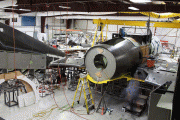
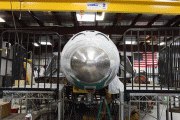
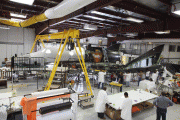
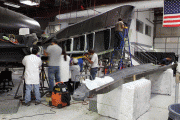
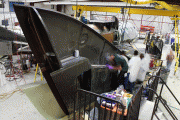
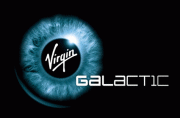
Virgin Galactic's bullet-nosed rocket, SpaceShipTwo, coming together in the hangar of Scaled Composites in Mojave, California.
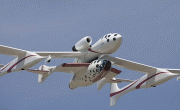
Taking to the skies: Mothership White Knight Two has been doing test runs with SpaceShipOne while SpaceShipTwo was being built
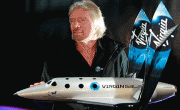
Grand unveiling: SpaceShipTwo will finally be presented to the public after five years of secret construction
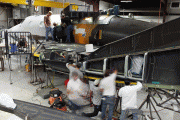
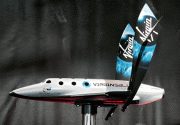
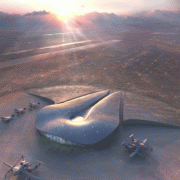





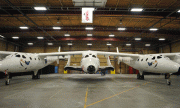
Click to enlarge.SpaceShipTwo, slung beneath WhiteKnightTwo, the launch aircraft that will carry Virgin Galactic's spacecraft out of the Earth's atmosphere.
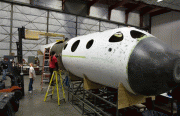
The Final Countdown: October 15, 2009: Virgin Galactic’s bullet-nosed rocket, SpaceShipTwo, sits in the hangar of Scaled Composites in Mojave, California, awaiting a paint job before its public debut in December.This undated image provided by Virgin Galactic shows placement of the center beam during SpaceShipTwo's construction inside the Scaled Composites plant at the Mojave Airport in Mojave, Calif. It has been five years since the first privately financed manned spacecraft captured the Ansari X Prize on Oct. 4, 2004, by demonstrating that a reusable rocket capable of carrying passengers could fly more than 62 miles high twice within two weeks. Turning the second part of that dream into reality has taken longer than many expected.
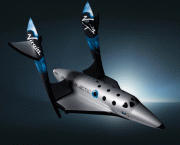


After five years of secret construction, the cloak is coming off a privately funded spacecraft designed to fly well-heeled tourists into space.
The long-awaited glimpse of SpaceShipTwo, slated for rollout Monday in the Mojave Desert, could not come sooner for the scores of wannabe astronauts who have forked over part of their disposable income for the chance to float in zero gravity.
"We've all been patiently waiting to see exactly what the vehicle is going to look like," said Peter Cheney, a 63-year-old potential space tourist from Seattle who was among the first to sign up for suborbital space rides marketed by Virgin Galactic. "It would be nice to see it in the flesh."
Virgin Galactic spokeswoman Jackie McQuillan promised a "theatrical unveil" followed by a cocktail party for paying passengers and other VIPs.
SpaceShipTwo's debut marks the first public appearance of a commercial passenger spacecraft. The project is bankrolled by Virgin Galactic founder, British billionaire Sir Richard Branson, who partnered with famed aviation designer Burt Rutan, the brains behind the venture.
SpaceShipTwo is based on Rutan's design of a stubby white prototype called SpaceShipOne. In 2004, SpaceShipOne captured the $10 million Ansari X Prize by becoming the first privately manned craft to reach space.
Since the historic feat, engineers from Rutan's Scaled Composites LLC have been laboring in a Mojave hangar to commercialize the prototype in heavy secrecy.
The last time there was this level of hoopla in the high desert was a little more than a year ago when Branson and Rutan trotted out to great fanfare the twin-fuselage mothership, White Knight Two, that will ferry SpaceShipTwo to launch altitude.
Despite the hype, hard work lies ahead before space journeys could become as routine as air travel.
Flight testing of White Knight Two has been ongoing for the past year. The first SpaceShipTwo test flights are expected to start next year, with full-fledged space launches to its maximum altitude by or in 2011.
It remains unclear when Virgin Galactic customers will receive their astronaut wings, but it will largely depend on how the test program fares. Some 300 clients have paid the $200,000 ticket or placed a deposit, according to the company.
SpaceShipTwo, built from lightweight composite materials and powered by a hybrid rocket motor, is similar to its prototype cousin with three exceptions. It's twice as large, measuring 60 feet long with a roomy cabin about the size of a Falcon 900 executive jet. It also has more windows including overhead portholes. While SpaceShipOne was designed for three people, SpaceShipTwo can carry six passengers and two pilots.
"It's a big and beautiful vehicle," said X Prize founder Peter Diamandis, who has seen SpaceShipTwo during various stages of development.
The ability to view Earth's curvature from space has been limited so far to government astronauts and a handful of wealthy people who have shelled out millions to board Russian rockets to the orbiting international space station.
After SpaceShipOne's history-making flights, many space advocates believed private companies would offer suborbital space joyrides before the end of this decade.
George Washington University space policy scholar John Logsdon called the milestones to date "measured progress."
"They've been appropriately cautious and making sure that every step is done correctly," he said.
Tragedy struck in 2007 when an explosion killed three of Rutan's engineers during a routine test of SpaceShipTwo's propellant system. The accident delayed the engine's development.
Virgin Galactic plans to operate commercial spaceflights out of a taxpayer-funded spaceport in New Mexico that is under construction. The 2 1/2 hour trips — up and down flights without circling the Earth — include about five minutes of weightlessness.
SpaceShipTwo will be carried aloft by White Knight Two and released at 50,000 feet. The craft's rocket engine then burns a combination of nitrous oxide and a rubber-based solid fuel to climb more than 65 miles above the Earth's surface.
After reaching the top of its trajectory, it will fall back into the atmosphere and glide to a landing like a normal airplane. Its descent is controlled by "feathering" its wings to maximize aerodynamic drag.
Virgin Galactic expects to spend more than $400 million for a fleet of five commercial spaceships and launch vehicles.
It's not the only player in the ultra-secretive commercial space race. A handful of entrepreneurs including Amazon.com Inc. Chief Executive Jeff Bezos, computer game programmer John Carmack and rocketeer Jeff Greason are building their own suborbital rockets with dreams of flying people out of the atmosphere.
Sir Richard Branson will reveal the Virgin Galactic commercial spacecraft at the Mojave Air and Spaceport tonight, offering a glimpse of the first spaceship designed to carry private passengers.
The unveiling of SpaceShipTwo marks one small step for the future of space tourism, and one giant $200,000 leap for any passenger who wants on board.
Is the journey worth the hefty price tag? Keep reading for more details about this innovative voyage.
Last year, Branson and American designer Burt Rutan revealed the highly anticipated White Knight Two, the mother ship that will carry SpaceShipTwo to its launch altitude.
Tonight, space enthusiasts can feast their eyes on the sleek ship that will actually hold the six passengers and two pilots on their journey into space.
SpaceShipTwo’s cabin is 7.5 feet in diameter by 12 long with a slick, wavy interior reminiscent of an Apple product. More importantly, it’s dotted with several porthole windows to give travelers plenty of opportunities to gaze out into space.
Virgin's SpaceportThe passenger pod isn’t designed to launch from the ground, so the mother ship will carry it to 50,000 feet, at which point SpaceShipTwo will disengage and ignite its own rocket, accelerating to 2,600 mph.
Passengers will officially become space tourists at an altitude of 62.1 miles as they cross the boundary between earth’s upper atmosphere and space. Soon after, at 65 miles high, the private astronauts will experience weightlessness for about six minutes. During this period, they’ll be able to unfasten their seatbelts, float about from porthole to porthole and admire the Earth’s curvature against the backdrop of space, a sight previously reserved only for government astronauts.
At this point, SpaceShipTwo’s wings will “feather out” to optimize resistance, allowing it to fall back through the atmosphere like a shuttlecock. The wings will convert to “glider mode” at an altitude of about 13 miles to take the ship back home. The entire trip from takeoff to landing will last an estimated 2.5 hours.
The next phase for Virgin Galactic is an extensive series of safety tests. Engineers hope to launch the SpaceShipTwo on a test run to its maximum altitude by 2011.
Branson is optimistic that his project will send thousands of people into space in the next few years. According to Virgin Galactic, more than 300 people have already reserved their spots.
Travel specialist group Virtuoso is the official sales channel for Virgin Galactic flights. Currently, there are three deposit options available: Founders, who will be on the first 100 commercial seats; Pioneers, comprised of 350-400 travelers who will fly within the first year of operation; and Voyagers, who will travel at a later date. And no, U.S. citizens do not need a visa to fly into space.
------------
-------------
-----------
-----------
------------
----------
RELATED POSTS:-





0 comments:
Post a Comment